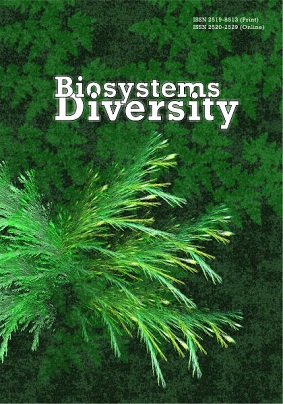The dynamics of the population and peculiarities of the morphometric structure of Melophagus ovinus (Diptera, Hippoboscidae) in Ukraine
The dynamics of the population and peculiarities of the morphometric structure of Melophagus ovinus (Diptera, Hippoboscidae) in Ukraine
Author(s): Y. O. Borodai, N. S. Kanivets, L. V. Nagorna, O. B. Prijma, O. V. Sirenko, V. V. Melnychuk, T. A. Sharavara, V. A. YevstafyevaSubject(s): Energy and Environmental Studies, Environmental Geography, Sociobiology
Published by: Дніпропетровський національний університет імені Олеся Гончара
Keywords: bloodsucking insect; sheep; index of abundance; intensity of infestation; differential signs;
Summary/Abstract: The indices of the Melophagus ovinus (Linnaeus, 1758) population in Ukraine, and also the peculiarities of morphological and metric structure of the insects’ body at all the stages of their development within the conditions of the surveyed region were investigated. New data on morphometric differential signs of sexually mature males and females of sheep bloodsuckers were obtained. It was established that M. ovinus are significantly widespread in Poltava and Zaporizhzhia regions, and they parasitize 26.1% of the examined sheep stock with the infection intensity of 92.7 ± 1.4 specimens and abundance – 24.7 specimens on one animal. The dynamics of M. ovinus population at different stages of development was characterized by the highest abundance of sexually mature males (11.1 specimens) and females (8.9 specimens). The given index concerning pupae and larvae was considerably lower (4.2 and 0.5 specimens on one animal). It was found that post-embryonic and adult development stages of M. ovinus differ in their metric indices. The length and width of the pupae were 17.4% and 13.2% larger than those of the larvae. The sizes of males and females relative to the indices of body length, the length and width of head, thoracic, and abdominal segments, the length of maxillary palpus and the length and width of the proboscis in fact differ in their values. The differential morphological species signs of M. ovinus are the form and location of oculi, antennae, the structure of the head segment of the body, and the mouthparts, and of sexual dimorphism – the distance from the caudal segment of the copulatory apparatus to the rear of the insect’s last abdominal segment.
Journal: Biosystems Diversity
- Issue Year: 25/2017
- Issue No: 3
- Page Range: 243-248
- Page Count: 6
- Language: English

